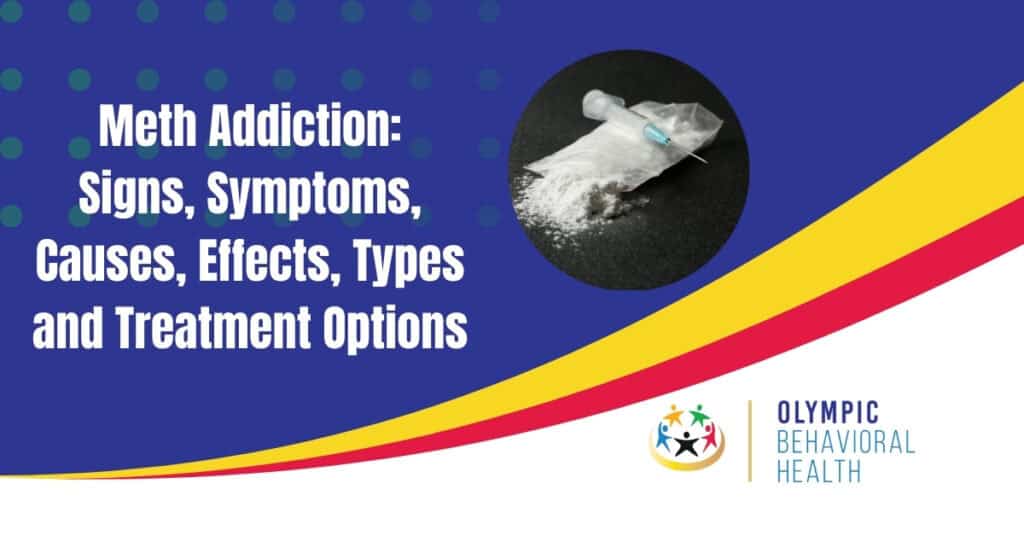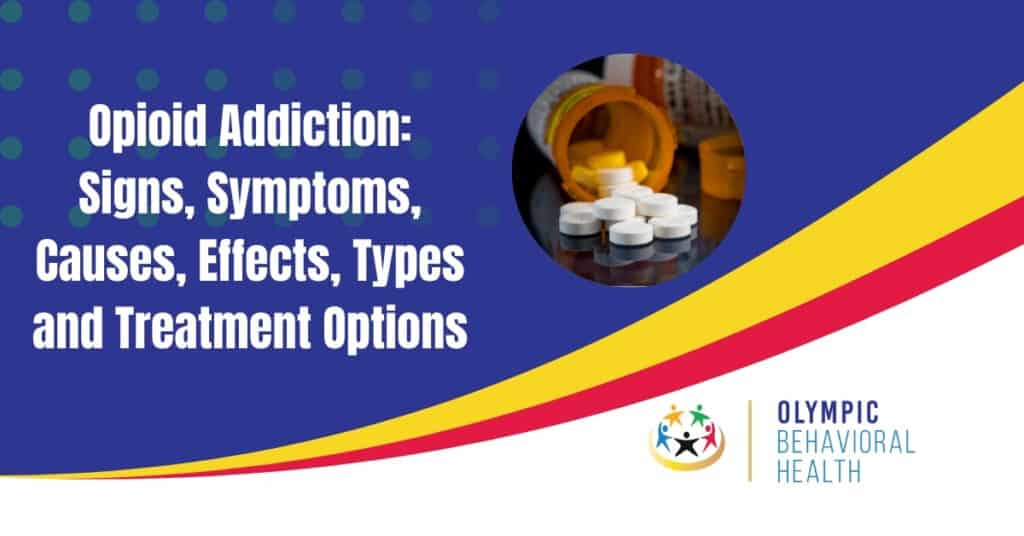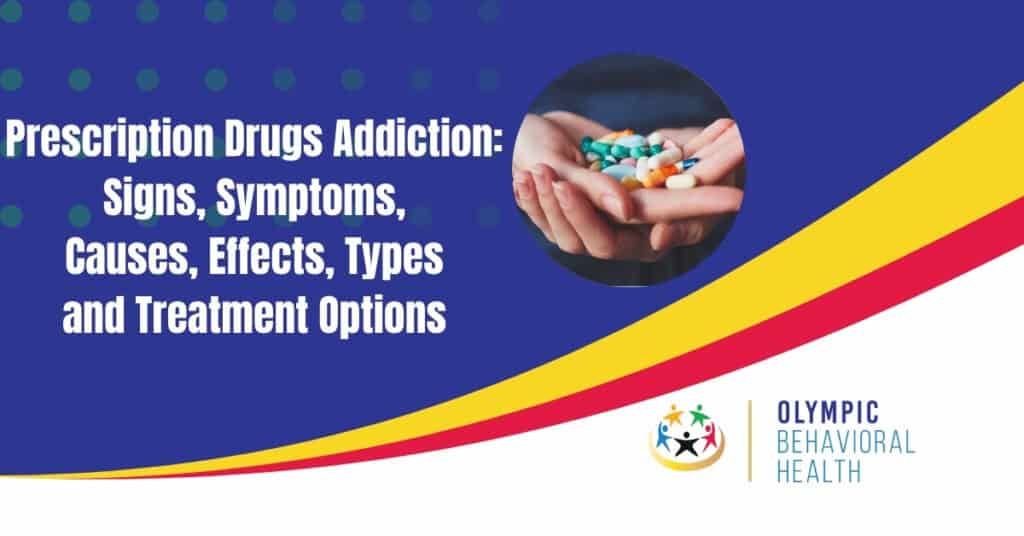Methamphetamine, often shortened to meth, is a highly addictive stimulant that disrupts the central nervous system. It appears as a crystalline powder and is easily misused due to its potent effects. Meth addiction is the compulsive, continuous use of meth despite negative consequences for the user. It is classified clinically by the American Psychiatric Association (APA) under Stimulant Use Disorder.
Meth addiction can manifest in various ways. Physical signs include rapid weight loss, erratic behavior, dilated pupils, and skin sores. Psychological symptoms can include mood swings, anxiety, paranoia, hallucinations, and difficulty sleeping. Social changes like neglecting responsibilities and isolating from loved ones are also common.
Multiple factors contribute to meth addiction. Genetics can play a role, in increasing someone’s susceptibility. Mental health issues like depression or anxiety can also lead individuals to self-medicate with meth. Social influences and exposure to drug use in a person’s environment can further increase the risk.
Meth addiction has devastating consequences. The brain suffers long-term damage, affecting memory, learning, and emotional regulation. Physical health deteriorates, with risks of heart problems, stroke, and organ damage. Mental health issues worsen, and psychosis can develop in some cases.
Breaking free from meth addiction requires comprehensive treatment. Detoxification helps manage withdrawal symptoms in a safe setting. Behavioral therapy equips individuals with coping mechanisms to prevent relapse. Medication-assisted treatment can address co-occurring mental health issues. Support groups provide a sense of community and encouragement during recovery. With dedication and the right support system, individuals can overcome meth addiction and rebuild a healthy life.

What is Meth?
Methamphetamine, often shortened to meth, is a powerful and highly addictive stimulant that directly impacts the central nervous system. It appears as a white, crystalline powder with no odor and a bitter taste, and it can be easily dissolved in water or alcohol.
Developed in the early 20th century from amphetamine, meth was initially used in medications like nasal decongestants and bronchial inhalers. Similar to amphetamine, it increases activity and talkativeness, suppresses appetite, and creates a pleasurable sense of well-being or euphoria.
However, there’s a crucial distinction between the two drugs. At comparable doses, meth allows significantly more of the substance to enter the brain, making it a much stronger stimulant. This translates to longer-lasting and more harmful effects on the central nervous system, increasing the risk of misuse and addiction.
These potent characteristics have led the U.S. Drug Enforcement Administration (DEA) to classify methamphetamine as a Schedule II stimulant. This classification places strict limitations on its legal availability, requiring a non-refillable prescription for any legitimate medical use. While meth may be prescribed in rare cases for attention deficit hyperactivity disorder (ADHD) or as a short-term component in weight-loss treatments, these applications are uncommon, and the prescribed dosages are far lower than those typically seen in illegal misuse.
How do you get addicted to Meth?
Meth addiction can take hold surprisingly fast. Initially, users are drawn to the powerful euphoria and increased energy caused by a surge of dopamine in the brain. This creates a strong desire to repeat the experience. Repeated use leads to tolerance, meaning they need more and more of the drug to achieve the same pleasurable effects. This cycle fuels dependence, where the body craves meth to function normally. Withdrawal symptoms like fatigue, depression, and intense cravings further reinforce the cycle of use, making it difficult to quit.
What are the Symptoms of a Meth Addiction?
Meth addiction can cause a variety of physical, behavioral, and psychological symptoms. Here are some of the most common:
Physical Symptoms
- Increased heart rate and blood pressure
- Insomnia
- Loss of appetite and weight loss
- Damage to teeth and gums (often referred to as “meth mouth”)
- Skin sores
- Picked-at skin
- Excessive sweating
- Dilated pupils
- Tremors
- Malnutrition
Behavioral Symptoms
- Engaging in risky or criminal behavior
- Increased aggression
- Paranoia
- Mood swings
- Anxiety
- Depression
- Social isolation
- Withdrawing from loved ones
- Lying or hiding drug use
- Financial problems
- Stealing money or belongings to buy meth
Psychological Symptoms
- Psychosis, which can include hallucinations and delusions
- Difficulty concentrating
- Memory problems
- Confusion
- Repetitive behaviors
If you are concerned that someone you know may be addicted to meth, it is important to seek professional help. Meth addiction is a serious condition that can have devastating consequences.
What are Signs that Someone is Addicted to Meth?
The signs of meth addiction can be both physical and behavioral. Here’s a breakdown to help you identify them:
Physical Signs
- Unnatural Energy and Sleeplessness: They might exhibit excessive alertness and go for days with minimal sleep.
- Weight Loss: Appetite loss is common, leading to noticeable thinning.
- Skin and Hygiene Issues: Skin sores, picking at skin, and poor hygiene due to a decline in self-care are giveaways.
- Physical Tics: Twitching, facial tics, and jerky movements can be signs of meth use.
Behavioral Signs
- Secrecy and Deception: Increased secretiveness about whereabouts and activities can be a red flag.
- Financial Problems: Meth addiction is expensive, so borrowing money or financial strain could be a sign.
- Neglecting Responsibilities: School, work, and personal obligations are often neglected due to drug use.
- Risky Behavior: Engaging in dangerous activities despite the consequences is a serious sign.
- Changes in Social Life: Withdrawal from friends and family or associating with new, negative circles is common.
- Legal Issues: Meth use can lead to risky behavior resulting in legal problems.
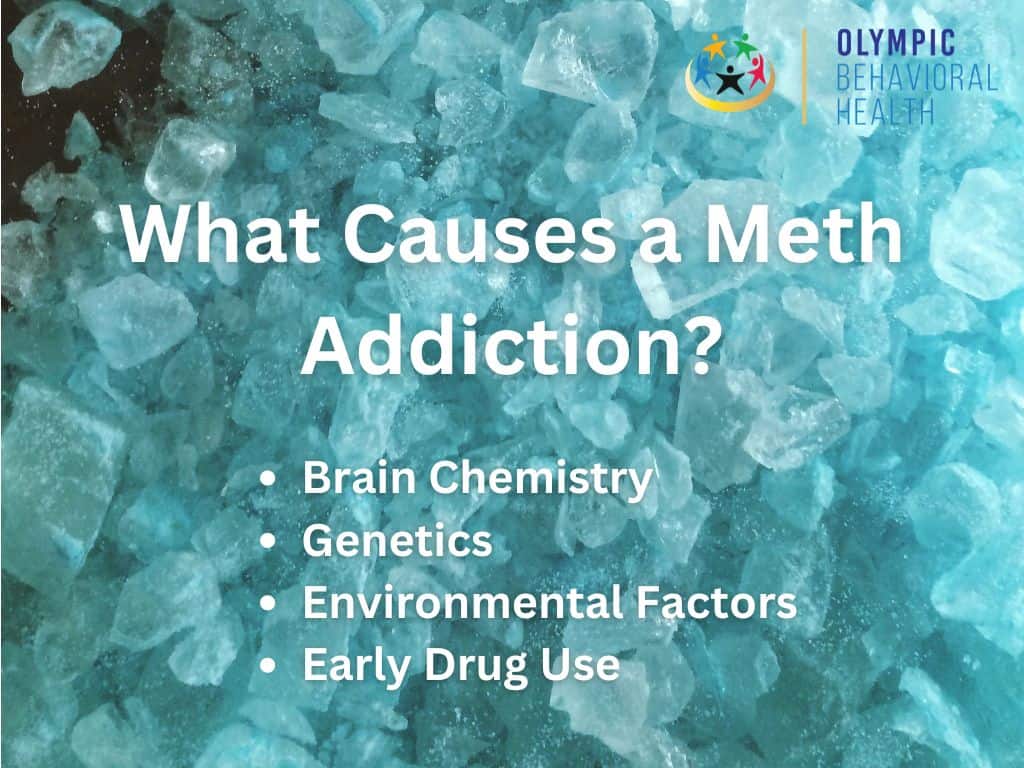
What Causes a Meth Addiction?
Meth addiction is a complex issue caused by a combination of factors, not just one single reason. Here’s a breakdown of the main contributors:
- Brain Chemistry: Meth is highly addictive because it floods the brain with dopamine, a neurotransmitter that creates feelings of pleasure and reward. This intense rush is much stronger than what the brain produces naturally. Over time, repeated meth use disrupts the brain’s dopamine system, making it difficult to feel pleasure without the drug.
- Genetics: People with a family history of addiction are more susceptible to developing an addiction themselves. This suggests genes may play a role in how a person’s brain reacts to addictive substances.
- Environmental Factors: A person’s environment can significantly influence their risk of addiction. Factors like childhood trauma, mental health issues, lack of social support, and exposure to drug use in their surroundings can all increase the chances of developing an addiction.
- Early Drug Use: Starting to use drugs, especially meth, at a young age significantly increases the risk of addiction. The younger the brain is when exposed to drugs, the more susceptible it is to long-term changes.
It’s important to understand that addiction is a disease, not a personal failure. If you or someone you know is struggling with meth addiction, there is help available. Professional treatment centers can provide the support and resources needed to overcome addiction and achieve recovery.
What are the Effects of Meth?
Methamphetamine, also known as meth, has a range of negative effects that can be felt immediately after use (short-term) and with continued use over time (long-term). Here’s a breakdown of what meth does to the body and mind:
Short-Term Effects
- Physical: Increased heart rate, blood pressure, and body temperature; rapid breathing; loss of appetite; insomnia; nausea; irregular heartbeat; tremors.
- Psychological: Euphoria (rush of pleasure), increased alertness and energy, decreased fatigue, impaired judgment, anxiety, irritability, aggression.
Long-Term Effects
- Physical: Severe damage to heart and brain function; increased risk of heart attack, stroke, and organ damage; weight loss; skin sores; dental problems (“meth mouth”); malnutrition.
- Psychological: Psychosis (hallucinations, delusions, paranoia), severe mood swings, depression, anxiety, confusion, memory problems, difficulty concentrating.
- Behavioral: Increased risk-taking behavior, social isolation, neglecting responsibilities, financial problems, criminal activity, lying or hiding drug use.
Additional Effects
- Addiction: Meth is highly addictive, and users can quickly develop a tolerance, needing more and more of the drug to get the same effect. This can lead to a vicious cycle of dependence and compulsive drug use.
- Increased Risk of Infectious Diseases: Sharing needles or other drug paraphernalia can increase the risk of contracting diseases like HIV and hepatitis.
These are just some of the most common effects of meth use. The severity of the effects can vary depending on the amount and frequency of use, as well as the individual’s overall health. Meth use can have devastating consequences for a person’s physical and mental health, relationships, and overall well-being.
How does someone develop a Meth addiction?
Methamphetamine, or meth, is a highly addictive stimulant that hijacks the brain’s reward system. Once in the bloodstream, meth floods the brain with dopamine, a neurotransmitter associated with pleasure and motivation. This creates an intense euphoria that can be very attractive, especially for someone seeking to escape emotional pain or boost energy.
Repeated meth use leads to tolerance, meaning the user needs higher doses to achieve the same pleasurable effects. This creates a dependence, where the body craves the drug to function normally. Meth’s high is intense but short-lived. This pattern often leads to binges, followed by crashes with intense withdrawal symptoms like fatigue, depression, and cravings. These crashes fuel the desire to use again, perpetuating the cycle.
Underlying Risk Factors:
- Genetics: Addiction can have a hereditary component, making some people more susceptible to meth’s addictive properties.
- Mental Health: Individuals with pre-existing mental health conditions like depression or anxiety may use meth to self-medicate, increasing the risk of addiction.
- Environmental Factors: Growing up in a chaotic household or having a social circle that uses meth can increase the likelihood of someone trying and potentially becoming addicted to the drug.
Meth addiction can develop very quickly, sometimes after just one use. It’s important to be aware of the signs and symptoms of addiction and to seek help if needed.
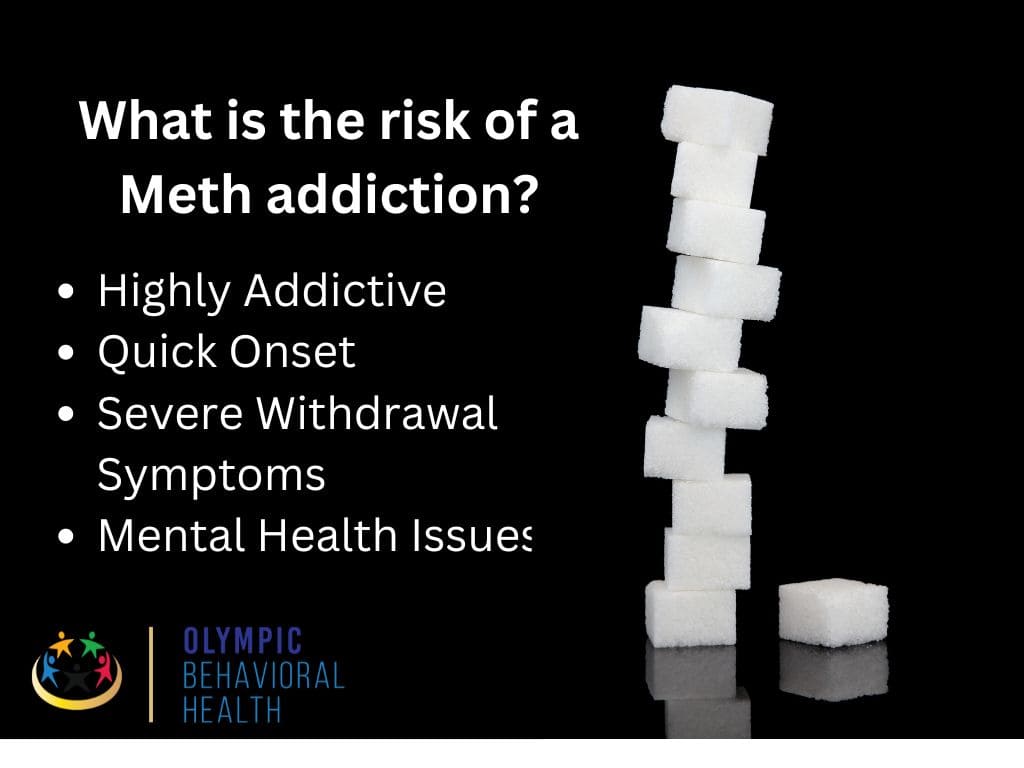
What is the risk of a Meth addiction?
The National Survey on Drug Use and Health (NSDUH) conducted in 2021 revealed that a concerning number of people struggle with methamphetamine use. Over 16.8 million people aged 12 or older (or 6.0% of the population) reported having used meth at least once in their lifetime.
In that same year, an estimated 2.5 million people reported using meth within the past year, solidifying its status as one of the most commonly misused stimulants globally. Therefore, the risk of meth addiction is extremely high. Here are some other reasons why
- Highly Addictive: Meth rapidly alters brain chemistry, creating a powerful dependence. The pleasurable effects lead to strong cravings, making it difficult to resist use.
- Quick Onset: Addiction can develop very quickly, sometimes after just one use. This is because meth has such a strong impact on the brain’s reward system, specifically the dopamine system.
- Severe Withdrawal Symptoms: When someone stops using meth, they experience intense withdrawal symptoms like fatigue, depression, and intense cravings. These can be extremely uncomfortable and drive continued drug use.
- Brain Damage: Meth use can permanently damage the brain, leading to problems with memory, learning, and emotional regulation. This damage can further increase the risk of addiction.
- Mental Health Issues: Meth use can worsen pre-existing mental health conditions like anxiety and psychosis, creating a difficult cycle to break.
Overall, meth is a dangerous and addictive drug. The risk of addiction is significant, and the consequences can be devastating.
How Can You Prevent a Meth Addiction?
There’s no foolproof way to prevent meth addiction, but here are some strategies that can significantly reduce the risk.
Education and Awareness
- Understanding the Risks: Open and honest conversations about the dangers of meth, including its addictive nature and long-term consequences, are crucial.
- Building Life Skills: Developing healthy coping mechanisms for stress and difficult emotions is important. Programs that teach communication, problem-solving, and emotional regulation can be valuable.
Strengthening Protective Factors
- Promoting Positive Relationships: Strong bonds with family, friends, and mentors can provide a support system that discourages drug use. Encouraging participation in positive activities and hobbies fosters a sense of purpose and belonging.
- Academic Success: Supporting academic achievement can boost self-esteem and provide a path to a fulfilling future, decreasing the appeal of drugs.
- Promoting Mental Health: Addressing underlying mental health issues like depression or anxiety can reduce the urge to self-medicate with meth. Early intervention and access to mental health services are crucial.
Reducing Risk Environments
- Avoiding Peer Pressure: Resisting pressure to use drugs in social settings is important. Role-playing and practicing refusal skills can help young people navigate these situations.
- Parental Monitoring: Open communication with children about their activities and friends can help parents identify potential risks and intervene if necessary.
- Community Outreach Programs: Community-based prevention programs that address the root causes of drug abuse, like poverty or lack of opportunity, can be highly effective.
Addiction is a complex issue, and prevention requires a multifaceted approach. By implementing these strategies, individuals and communities can significantly reduce the risk of meth addiction.
What withdrawal effects have Meth?
Meth withdrawal can be a very unpleasant experience, but it’s important to remember that it’s not life-threatening. Here’s a breakdown of the withdrawal effects of meth addiction:
Timeline of Symptoms
- Acute Withdrawal (1-2 weeks): This is the most intense phase, with symptoms typically appearing within 24 hours of the last meth use.
- Physical Symptoms: Fatigue, extreme hunger, headaches, nausea, vomiting, chills, sweating.
- Psychological Symptoms: Irritability, anxiety, depression, intense cravings for meth, difficulty sleeping or sleeping too much, paranoia, hallucinations (in some cases).
- Protracted Withdrawal (weeks or months): These symptoms are less severe but can linger for a long time.
- Psychological Symptoms: Predominantly include depression, anhedonia (inability to experience pleasure), and drug cravings. Difficulty concentrating and fatigue may also persist.
Important Considerations
- Severity Varies: The severity of withdrawal symptoms can vary depending on factors like the amount and duration of meth use, overall health, and individual differences.
- Suicidal Ideation: The intense depression and cravings experienced during withdrawal can increase the risk of suicidal thoughts or behaviors. It’s crucial to seek help if these arise.
Withdrawing from meth can be challenging, but it is possible. Medical detox and professional treatment can significantly ease withdrawal symptoms and increase the chances of long-term recovery.
Can you treat a meth addiction?
Yes, meth addiction can be treated, although there’s no single “cure.” Treatment focuses on managing withdrawal symptoms, preventing relapse, and fostering long-term recovery. Treatment often involves a combination of detoxification, behavioral therapy, and medication if necessary.
Meth addiction treatment can be very effective, but success depends on factors like the individual’s commitment to recovery, the severity of addiction, and the type of treatment program. Early intervention is crucial for maximizing the chances of long-term recovery.
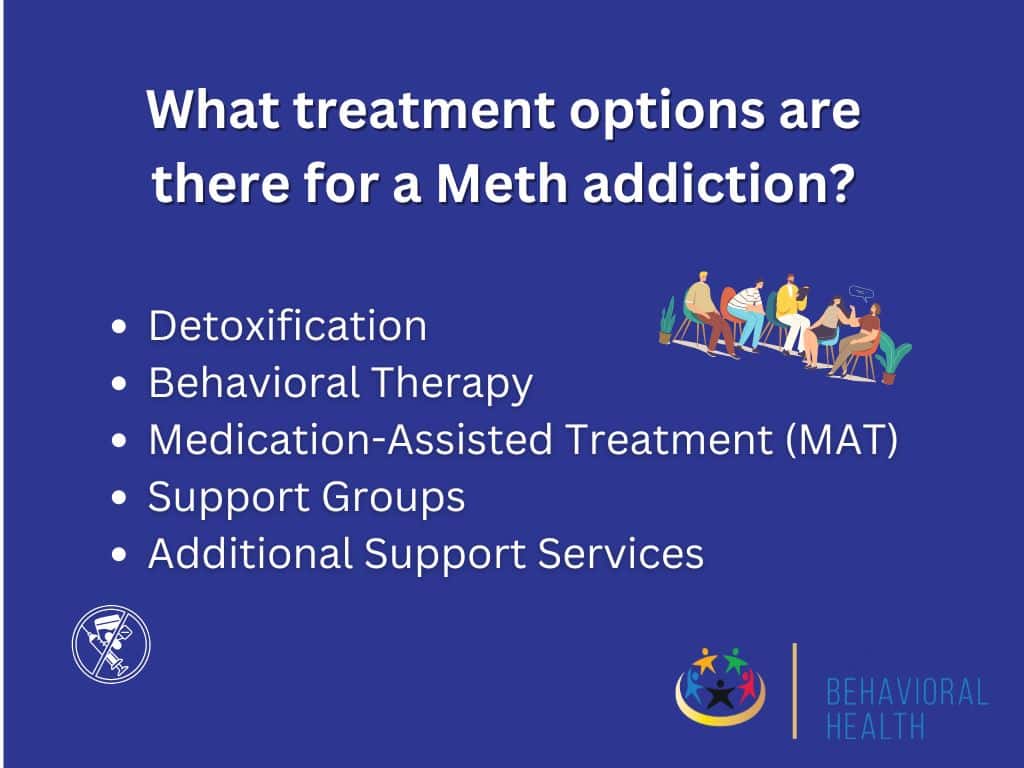
What treatment options are there for a Meth addiction?
There’s no one-size-fits-all solution for meth addiction treatment, but several effective approaches can be combined for a personalized recovery plan. Here’s a breakdown of the main options.
Detoxification
This is often the first step, involving medically supervised withdrawal under professional care. Detoxification helps manage the physical discomfort and cravings associated with stopping meth use in a safe and controlled environment.
Behavioral Therapy
Considered a cornerstone of meth addiction treatment, behavioral therapy equips individuals with tools to manage their addiction and prevent relapse. Here are some common approaches:
- Cognitive-behavioral therapy (CBT): CBT helps identify and change negative thought patterns and behaviors that contribute to drug use. Individuals learn coping mechanisms for dealing with stress, triggers, and cravings.
- Contingency management (CM): This approach uses a reward system to reinforce positive behaviors. For instance, vouchers or privileges might be offered for staying abstinent from meth, promoting positive reinforcement for staying on track.
- Motivational interviewing (MI): This technique helps individuals explore their ambivalence about change and build motivation to commit to recovery. Therapists work collaboratively, fostering a sense of empowerment and self-belief in the recovery process.
Medication-Assisted Treatment (MAT)
While there are currently no FDA-approved medications specifically for meth addiction, MAT can be helpful in some cases. Medications might be used to:
- Manage co-occurring mental health conditions like depression or anxiety, which can worsen addiction.
- Address specific withdrawal symptoms, making the detox process more manageable.
Support Groups
Support groups can be a powerful resource for individuals in recovery. Programs like Narcotics Anonymous or meth-specific support groups provide a sense of community, encouragement, and accountability. Sharing experiences with others who understand the challenges of addiction can be incredibly supportive.
Additional Support Services
Treatment programs may also offer additional services like:
- Individual therapy: Focused therapy sessions to delve deeper into underlying issues and develop coping mechanisms.
- Family therapy: Involving family members in the recovery process to create a supportive network and address any co-dependency issues.
- Vocational rehabilitation: Assisting individuals in finding or returning to employment, fostering a sense of purpose and stability.
How do you prevent a relapse?
Preventing relapse after meth addiction treatment requires a multifaceted approach. Here are some key strategies to consider.
Building a Strong Support System
- Therapy and Support Groups: Regular therapy sessions can help identify triggers, develop coping mechanisms, and address underlying issues that may contribute to relapse. Support groups provide a sense of belonging, accountability, and encouragement from others who understand the challenges of recovery.
- Relapse Prevention Planning: Work with a therapist to create a personalized relapse prevention plan. This plan should identify triggers (people, places, situations), early warning signs of relapse, and healthy coping mechanisms to manage those triggers and cravings.
- Building Healthy Relationships: Surround yourself with positive and supportive people who encourage your recovery. Nurture relationships with family and friends who understand your journey and can offer encouragement.
Maintaining Healthy Habits
- Self-Care: Prioritize self-care practices like healthy eating, regular exercise, and adequate sleep. These practices promote overall well-being and build resilience against stress and cravings.
- Mindfulness and Relaxation Techniques: Techniques like meditation, deep breathing, and yoga can help manage stress, anxiety, and cravings, which can be triggers for relapse.
- Avoiding Risky Situations: Identify and avoid people, places, and situations associated with past drug use. This might involve setting boundaries with certain individuals or avoiding specific locations.
Addressing Underlying Issues
- Treating Co-Occurring Mental Health Conditions: Mental health conditions like depression or anxiety can contribute to relapse. Addressing these conditions through therapy and medication can significantly reduce the risk.
- Building Life Skills: Develop healthy coping mechanisms for dealing with stress, boredom, and difficult emotions. Learn to manage conflict, communicate effectively, and solve problems in healthy ways.
- Relapse as a Learning Opportunity: If a relapse occurs, view it as a learning experience. Analyze what triggered the relapse and use it to strengthen your relapse prevention plan.
Seek Help
Relapse is a possibility, but it doesn’t have to derail your recovery journey. With the right support system, healthy habits, and a commitment to long-term well-being, you can overcome challenges and stay on the path to recovery.
We at Olympic Behavioral Health can help you when it comes to receiving appropriate treatment for meth addiction. We have excellent programs, and a top notch team designed specifically to help you overcome the clutches of your meth addiction.

Share This Post
